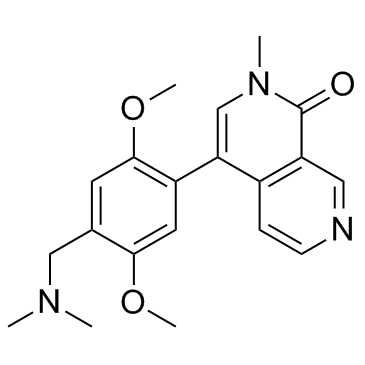1883429-22-8
| Name | 4-{4-[(Dimethylamino)methyl]-2,5-dimethoxyphenyl}-2-methyl-2,7-naphthyridin-1(2H)-one |
|---|---|
| Synonyms |
4-{4-[(Dimethylamino)methyl]-2,5-dimethoxyphenyl}-2-methyl-2,7-naphthyridin-1(2H)-on
2,7-Naphthyridin-1(2H)-one, 4-[4-[(dimethylamino)methyl]-2,5-dimethoxyphenyl]-2-methyl- 4-{4-[(Diméthylamino)méthyl]-2,5-diméthoxyphényl}-2-méthyl-2,7-naphtyridin-1(2H)-one 4-{4-[(Dimethylamino)methyl]-2,5-dimethoxyphenyl}-2-methyl-2,7-naphthyridin-1(2H)-one BI-9564 |
| Description | BI-9564 is a selective, and cell-permeable BRD9 BD inhibitor, with Kd of 5.9 nM for BRD9, and IC50 of > 100 μM for BET family. |
|---|---|
| Related Catalog | |
| Target |
Kd: 20 nM (BRD9) |
| In Vitro | BI-9564 (<5 μM) shows no activity against 324 kinases, and at 10 μM, an inhibition >40% is observed for only 2 out of 55 GPCRs. BI-9564 has antiproliferative effect on human acute myeloid eosinophilic leukemia cell line EOL-1, with EC50 of 800 nM[1]. BI-9564 shows Kd of 73 nM for BRD7, and is >10-fold more selective for BRD9 over the highly homologues bromodomain BRD7, which has been implied as a tumor suppressor and is down-regulated in cancer cells[2]. |
| In Vivo | BI-9564 (180 mg/kg, p.o.) shows attractive ADME/PK profiles for in vivo proof-of-concept studies. BI-9564 results in a modest but significant additional survival benefit of 2 days compared to survival of the control group in a xenograft model of human AML[1]. |
| Cell Assay | Cells are grown in 50 µL medium as specified by the supplier for 7 days starting with 500 and with 1000 cells per well of a 384 well plate in the presence of varying concentrations of compound before measuring viability via cellular ATP levels using the cell titer glow assay. |
| Animal Admin | Female CIEA-NOG mice are engrafted intravenously with 1×107 EOL-1 AML cells stably expressing luciferase and GFP. Following injection of the cells animals are randomized based on body weight (n=10/group). Treatment starts on day 5 with either 0.5% Natrosol or BI-9564 formulated with 0.5% Natrosol. All doses are calculated relative to the mouse body weight on the treatment day. BI-9564 and the vehicle control are administered orally with a dosing volume of 10 mL/kg body weight. BI-9564 is administered daily from day 5 until 17 and from day 20 until 22. Dosing is interrupted on day 18 for two days as one mouse in the treatment group reaches -15% body weight loss. Tumour load is measured 2-3 times weekly based on bioluminescence imaging. The following scoring system is used: score 0, no clinical signs; score 1, tail or hind limb weakness. Animals are sacrificed based on severity criteria including appearance of paralysis score 1 and/or body weight loss exceeding -18%. In S54 this tumor mouse model body weight changes can occur due to increased tumor load or due to intolerability. |
| References |
| Density | 1.2±0.1 g/cm3 |
|---|---|
| Boiling Point | 519.9±50.0 °C at 760 mmHg |
| Molecular Formula | C20H23N3O3 |
| Molecular Weight | 353.415 |
| Flash Point | 268.3±30.1 °C |
| Exact Mass | 353.173950 |
| LogP | 2.05 |
| Vapour Pressure | 0.0±1.4 mmHg at 25°C |
| Index of Refraction | 1.590 |
| Storage condition | -20℃ |
